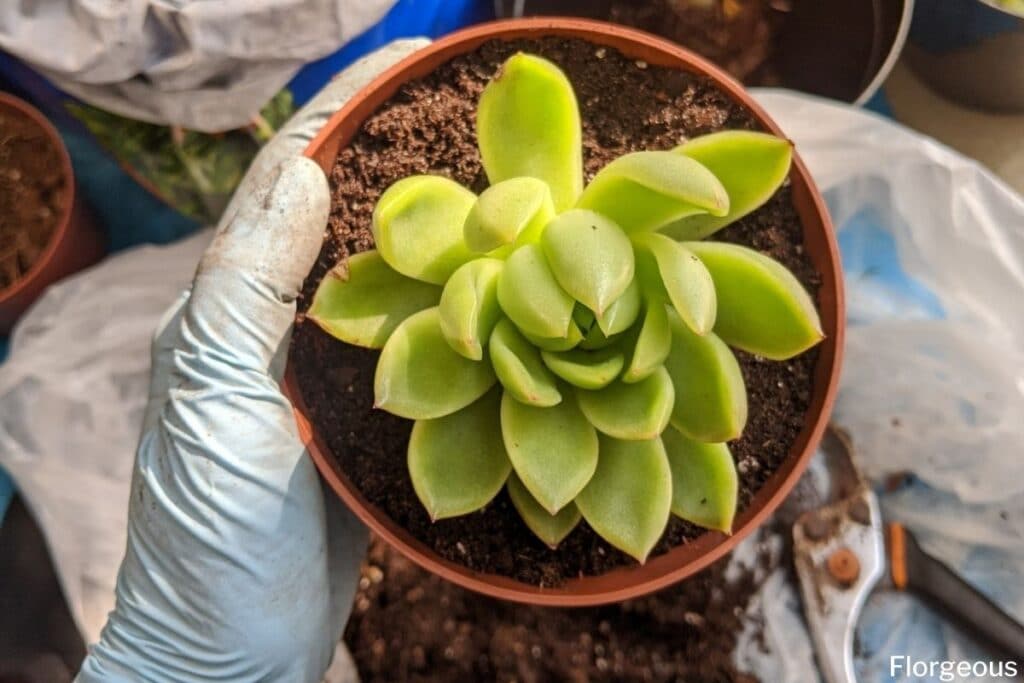Succulents are still among the most in-demand plants today. They come from different plant families that the beauty and interest they provide indoors is so diverse, you would want each one of them in your collection.
Some people would even pay so much for species and varieties that the market decides as rare and exotic. But did you know that you can grow your collection easily and for free by learning succulent propagation?
That is right, you can actually make more succulents through propagation! In fact, your succulents are already producing the key parts to grow your new plants, just waiting for you to get started.
Succulents only need 4 basic things; sunlight, fresh air, warmth, and dryness (1). If you got all of these right, your plants must be thriving and spreading in your pot or garden.
Propagation of Succulents
So when and how to grow succulents? When you look closely at your successful plants, you will probably notice some roots growing on the underside of the leaves and stems.
There may also be some tiny leaves growing at the base of the plant or that point where the entire leaf meets the stem. These are the obvious signs that you need to start propagating.

Like most plants, succulents can reproduce sexually (seeds) and asexually (vegetative parts) but depending on the type of succulents that you have, some methods are more effective and economical in propagating than others.
The 4 ways to propagate your succulents are by leaf cuttings, by stem cuttings, by division, and by seed (2).
When to Propagate Your Succulents

Plants grow actively during spring and summer when the weather is more favorable and there is more light so propagation during these times of the year is more successful. However, there will be an instance when a few leaves may randomly fall off from your plant. Propagate them instead of throwing away.
Mature succulents also tend to get leggy when they are not receiving enough sunlight. If your plant has lost a lot of leaves and starts to look unattractive, cut it in two, propagate, and with proper care, you will eventually have two new beautiful plants.
What is the Potting Mix for Succulents?
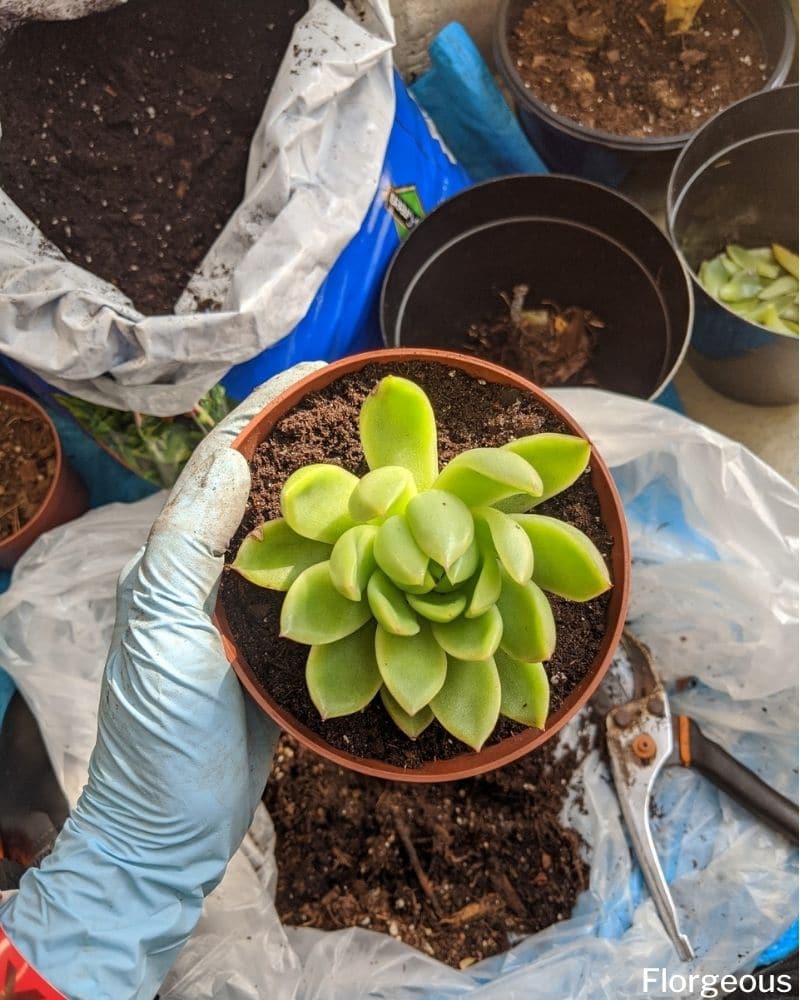
If there’s one thing that succulents do not like, it is standing water. They already have a good reserve of water in their system that wet soil will only cause them to rot. The key to keeping succulents flourishing is a well-draining soil. This is the best solution to prevent and treat succulent root rot.
When propagating and potting succulents, it is important to use a succulent soil mixture with enough porosity that will retain water to encourage root growth without being too wet (3). There are two components to a succulent potting mix, the organic matter (OM) and the mineral material (MM).

The OM often provides the nutrients and holds the moisture in the mix. You can use coco coir, garden loam, or compost. The MM like crushed lava rock, sand, charcoal, pumice, or perlite provides anchorage and drainage.
Although the MM generally has a higher ratio than the OM in a potting mix, the percentage may vary depending on the propagation method and the growth stage of the plant. MM ranges from 60 to 95% and 5 to 40% for OM. Some mixtures have added controlled-release fertilizers too (4).
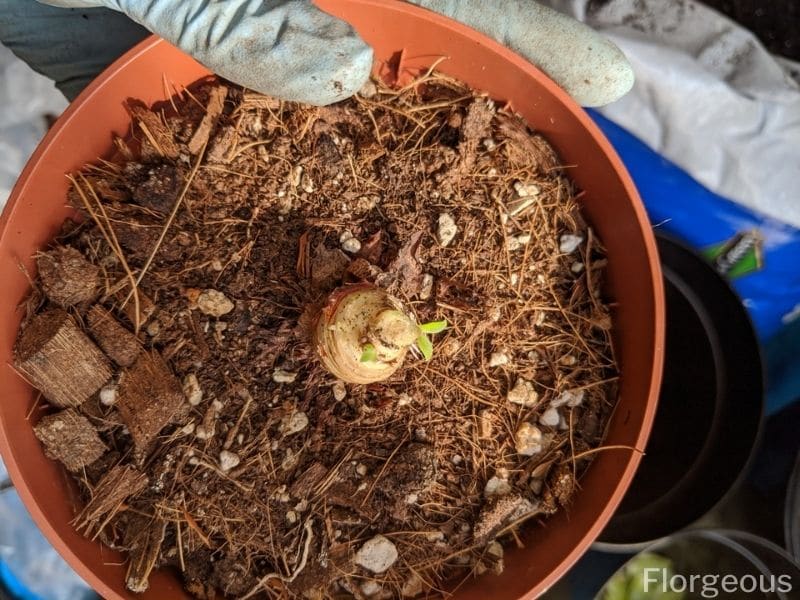
Once the propagules have established shoots and roots and are ready for potting, they should be planted using a soil mix with a top layer of fine grit or top dressing like sand or small rocks. This layer will prevent the base of the new plant from rotting by allowing the excess moisture in the mix to evaporate (3).
See more: How to repot succulents
Succulent Propagation Techniques
Here are the common ways how to propagate succulents. Some of these methods also work for hanging succulents and cacti.
By Leaf Cuttings
This is ideal for plants that have thick fleshy leaves such as echeveria, graptoveria, pachyveria, sedum, and bryophyllum.
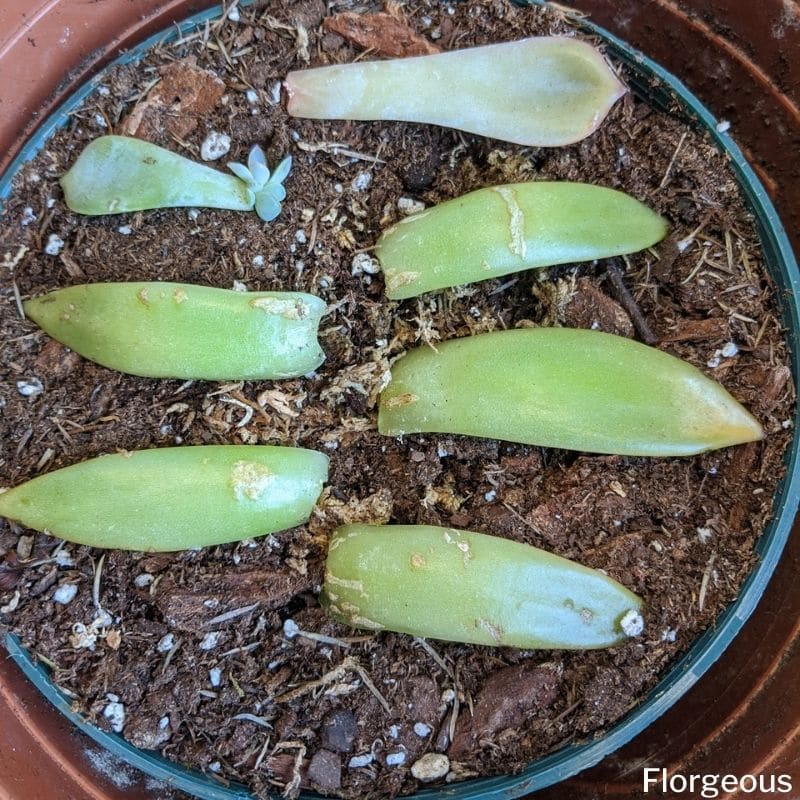
Here’s how to grow succulents from leaves:
- Step 1. Firmly tug on the healthy leaf to one side, ensuring the leaf do not tear and come off cleanly. If using cutting tools, use a sterilized sharp knife and make a clean cut so that the wound will heal fast. Choose the mature leaves but avoid the lower leaves near the base as they tend not to root well (4).
- Step 2. Lay the leaves concave side up on top of a paper towel or a coarse potting mix (80% MM and 20% OM) on a tray. Keep it under bright light but away from direct sun and do not water until roots have formed. Misting is preferable over running the water directly over the plants (1).
- Step 3. After 3-4 weeks, a cluster of small leaves will start developing from the base of the leaf and the leaf itself will shrivel as the new plant uses up the water and nutrient reserve. Fill your pot with the soil mix (60-75% MM, 25-40% OM) and top dressing and gently bury the roots of the plantlet.
- Step 4. Water the plant with distilled water immediately and let the excess water drain. Place the plant in a well-lit, airy location and do not water again until the soil is completely dry. Another way of watering is by allowing the pot to stand in lukewarm for a few minutes, this way the leaves will be free from water droplets and the fine grit will not be disturbed (4).
By Stem Cuttings
Succulents that can grow multiple hard or semi-hard stems and branches are ideal for this propagation. These are aeonium, kalanchoe, euphorbia, and stapelia (2).

Here’s how to grow succulents from cuttings:
- Step 1. Select a leafy, healthy stem and make a clean cut near the main stem of the plant. Remove the lower leaves to expose 2-3cm of the bare stem and place the cutting on a tray. Keep it away from direct sun, in a dry place for a few weeks until the wound has formed callus.
- Step 2. Fill a pot with 80-95% MM: 5-20% OM potting mix and fine grit and gently bury the stem until only the leaves are above the soil (4).
- Step 3. Water the plant thoroughly and allow it to drain. Place it in a warm, bright area and water again when the soil is dry. New roots will form after 3-4 weeks.
By Division
Many succulents have underground parts called tuber, corm, and bulb that can produce new identical plants. Plants like aloe, agave, sempervivum, kalanchoe, and haworthia produce offsets, pups, or plantlets that can be repotted and planted individually when you learn how to split succulents (4).
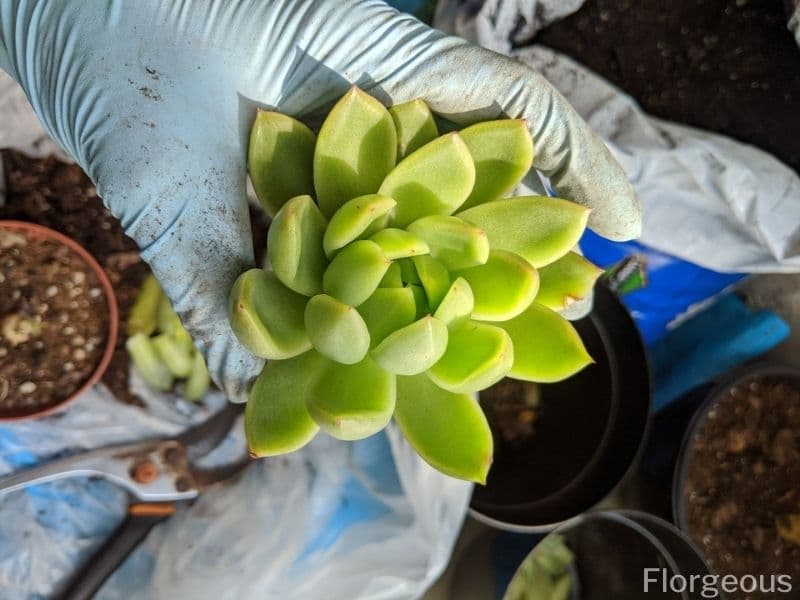
Here’s how to separate and divide succulents:
- Step 1. Moisten the soil and gently cut or wiggle the offsets from the mother plant. The dense roots may get tangled so carefully cut the plants loose. Remove the old and dry leaves and prune the roots of necessary (1).
- Step 2. Fill a pot with soil mixture (80-95%MM: 5-20%OM, controlled-release fertilizer) and top dressing and plant the pups or offsets individually, making sure that the base of the leaves is level with the soil surface.
- Step 3. After 2-3 days, water the baby plants thoroughly and allow it to drain. Like newly repotted plants, place it on a warm, dry area, protected from direct sunlight. Wait for the soil to dry before watering again.
By Seed
Almost all succulent plants can be propagated by seeds but it takes more time and patience. For some serious growers, this method is preferable because it prevents the transmission of viruses and diseases.
The plants live longer, the seeds have a longer shelf life, and it is always rewarding to watch the seeds germinate.
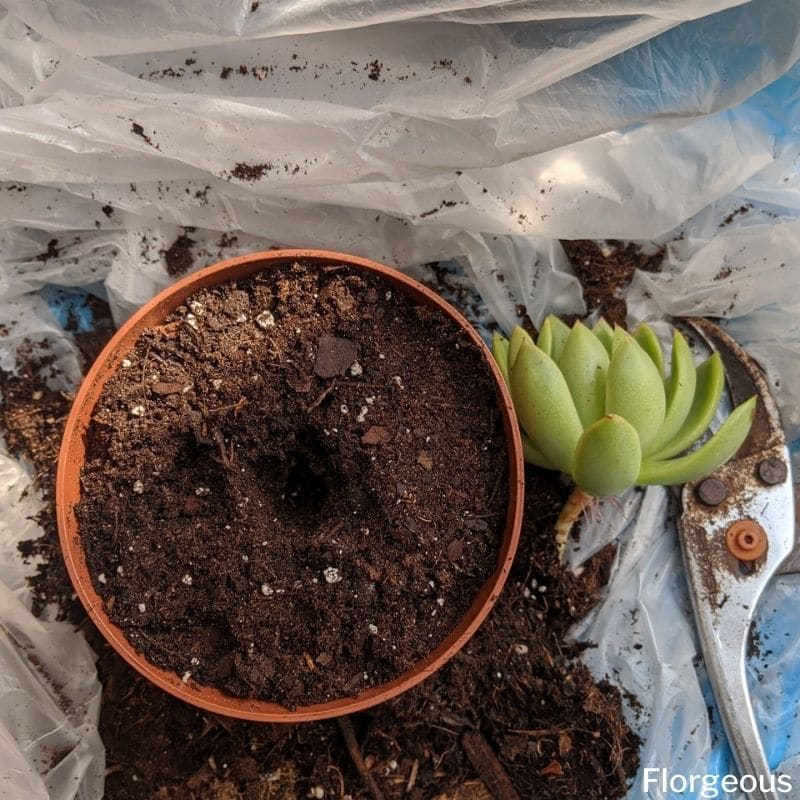
Here’s how to grow succulents from seeds:
- Step 1. To help loosen the seed coat and activate germination, soak the seeds in warm water for 30 mins right before planting. Fill a small pot with a potting mix (60-75%MM: 25-40%OM, controlled-release fertilizer) and sprinkle the soaked seeds (4).
- Step 2. Gently sprinkle a thin layer of top dressing, enough to cover the seeds before carefully watering. Allow the pot to drain completely (2).
- Step 3. Keep the pot under a translucent plastic container. This will serve as a miniature greenhouse to moderate the temperature and humidity without completely blocking the light. Apply water in moderation, only when the walls of the container lose moisture. Always reseal the setup but check for algal growth from time to time.
- Step 4. Depending on the species and growing environment, it may take a few weeks to months before the seed germinates. Remove the cover only when the plants seem to have overgrown. This will ensure that they have fully developed roots before transplanting.
- Step 5. Make sure that the soil is moist before transplanting. Gently repot in a soil mix-filled pot and add a layer of top dress. Water after 3-4 days.
FAQs
Can you put succulent cuttings straight into soil?
Yes, you can put succulent cuttings straight into soil for propagation. Allow the cut ends to callus over for a day or two before planting to prevent rotting.
Is it better to propagate succulents in water or soil?
While both water and soil propagation methods can be successful for succulents, many growers find that rooting cuttings directly in soil yields better results. Soil propagation encourages the development of a strong root system and reduces the risk of rotting compared to water propagation.
Can all succulents grow from cuttings?
Many succulents can grow from cuttings, including popular varieties like Echeveria, Sedum, and Crassula. However, success rates may vary depending on the species and the condition of the cutting.
Do succulent cuttings need to dry out before planting?
Yes, it’s generally recommended to allow succulent cuttings to dry out and callus over before planting. This helps prevent moisture-related issues like rotting and encourages the development of roots once the cutting is planted.
What is the fastest way to root succulents?
The fastest way to root succulents is to take healthy cuttings, allow them to callus over for a day or two, and then plant them in well-draining soil. Provide bright, indirect light and avoid overwatering to encourage root growth. Some growers also use rooting hormone to stimulate faster root development, although it’s not always necessary.
We hope this guide gives you all the tips you need to grow and replant succulents by cutting, rooting, leaves and seeds. Happy propagating!
See more: How to grow and care for succulents
References
Reference List:
(1) Baldwin, D. Designing with Succulents. Timber Press. 2017. P. 304.
(2) Bailey, F. & Allaway, Z. Practical Cactus and Succulent Book: How to Choose, Nurture, and Display 200 Cacti and Succulents. Penguin. 2019. P. 224.
(3) Toogood, A. Propagating Plants: How to Create New Plants for Free. Penguin. 2019. P. 320.
(4) Neisen, P. Propagation of Cacti and Succulents. North Dakota State University. https://www.ndsu.edu/pubweb/chiwonlee/plsc368/student/papers01/pneisen/Propagationofcactiandsucculents/cactuspropagation.htm. Accessed on 23 August 2020.
Close

